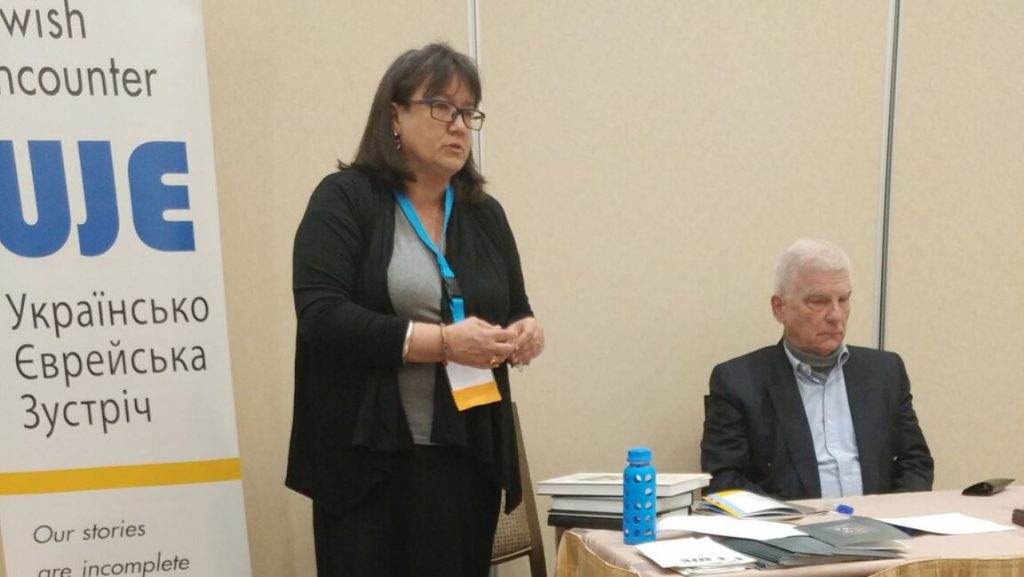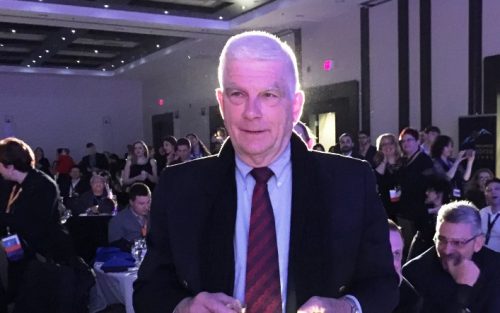Ukrainians and Jews: Exploring the relationship through a wider perspective (Canada’s Limmud FSU, Part 2)

The participants of a recent presentation on Ukrainian-Jewish relations were direct and unambiguous when asked about their perceptions of Ukrainians: Ukrainians are antisemites. Most cooperated with the Nazis during World War II. They carried out pogroms against the Jewish people. One woman noted relatives had been saved from a brutal fate at Babyn Yar by a Ukrainian family, but wondered about the bystanders. After all, there were other killing fields in Ukraine.
The presenter, Professor Paul Robert Magocsi of the University of Toronto, was equally unambiguous in his response: Ethnic groups aren’t homogeneous. Ethnic Ukrainians saved Jews during the war. The historical experience of Jews and Ukrainians is more similar than different. Periods of violent discord should not summarize and define the entire relationship between the two peoples.
How Ukrainians and Jews view each other is often complicated. The two peoples have lived side-by-side for over a millennium on the territory of what is modern-day Ukraine. Yet the experience of the twentieth century has left an indelible mark, leaving both communities often at odds over history and memory.
The three books that Magocsi presented at the Limmud FSU Canada conference at Blue Mountain, Ontario on 26 March 2017, and which were the basis of his talk there, underscored that the complex historical relationship between the two peoples has not been black and white.
The books included: The Ukrainian-Jewish Encounter: Cultural Dimensions (edited by Wolf Moskovich and Alti Rodal), which explores cultural interactions between Ukrainians and Jews over the centuries; Babyn Yar: History and Memory (edited by Vladislav Hrynevych, Sr. and Magocsi), a collection of monographs written by international scholars that for “the first time really deals with this place in a comprehensive manner”; plus Jews and Ukrainians: A Millennium of Co-Existence, which Magocsi co-authored with Yohanan Petrovsky-Shtern of Northwestern University.
Magocsi said his own work is an attempt to provide a “larger historical context” of the Ukrainian-Jewish experience to a broader international audience.
“The approach is not a history of Jews in Ukraine, nor is it a history per se,” he said. “It is rather an attempt to look at the roughly 1,000 years at the onset, certainly 450 years of evolution of both of these cultures as distinct cultures…in which one looks at history but also at traditional culture, folklore, beliefs religion, art, theatre, the diaspora…and what was achieved in each of these domains.”
The book early on addresses some of the misperceptions and stereotypes Jews and Ukrainians have of each other. A sidebar includes perceptions ranging from the era of the seventeenth-century Cossack leader Bohdan Khmelnytski to the modern-day.
Asked if Ukrainians are antisemitic, Magocsi noted: “There are no Ukrainians and there are no Jews in the sense of what are we talking about when we mention any group and then attribute to any group—and in this particular case if we are talking about national ethnic groups...as if this is some kind of homogenous phenomenon implying that all of the people, all of the individuals that we are assuming comprise a group for which we are using a label—somehow think and act in the same way.”
Magocsi underlined, “This verges on the absurd, even though we do it all the time.
So having said what I just said, it’s very easy to say that no, not all Ukrainians are antisemites because the very concept of talking about all a people is impossible. All that one can say is that yes, there are antisemitic tendencies, beliefs, activities…that exist among all peoples who lived alongside Jews at any time and at any place. That, I hope, is not considered obfuscation.”
Without doubt, one of the most painful chapters in the Ukrainian-Jewish relationship is the massacre that occurred at Babyn Yar, a ravine in Kyiv during the Second World War. There, on 29-30 September 1941, nearly 34,000 Kyiv Jews were shot to death by German forces in one of the most horrific chapters of the Holocaust. Over the next two years, tens of thousands of others from various ethnic and religious backgrounds, including Soviet prisoners of war, Ukrainian nationalists, Roma, the physically and mentally handicapped, were also murdered there.
Babyn Yar: History and Memory is an attempt to look at what happened through a wider lens and broader perspective.
“This is a book not simply about the initial tragedy that began on 29-30 September 1941 and the subsequent murders and killings,” said Magocsi. “Babyn Yar needs to be understood in a larger context. First the physical setting, the geography, and its role in Kyiv before the Second World War. It was a recreational site, but it is also a symbol. Not only is it a symbol of one aspect of the Holocaust, the Holocaust by Bullets, which was the preferred approach by the Germans during the Holocaust in the east…it also became a symbol of killing techniques.”
Chapters in the book examine how Babyn Yar was subsequently treated in art, music, cinema, political discourse, and battles over memory.
In speaking to the woman whose family was saved from a certain death at Babyn Yar by a Ukrainian family, Magocsi noted the importance of her observation:
“The comment…is a confirmation in many ways of what we are saying. First of all you’re knowledgeable about the fact that some ethnic Ukrainians were responsible for saving your family…this confirms in actual fact what I otherwise have said. And of the other thing you are absolutely right. Babyn Yar, as I said, is a symbol, and being a symbol, it’s a symbol of many similar communities with ravines, like outside of Kharkiv, where there is another ravine [where Jews were executed]. It didn’t have to be an actual ravine, it could have been a pit that was created, but this happened all over…those lands occupied by Nazi German forces” in Ukraine and Belarus.

Despite a complicated past, Magocsi noted Ukrainians and Jews should not lose sight that they have a shared historical experience. He elaborated, “It’s very important to remember the following: The experiences of both peoples until 1948 or 1991…was exactly the same in one…important way. Both were stateless peoples. Neither ethnic Ukrainians nor Jews had their own state. Rather, they lived on territory where they were subordinate…to another state, whether it was the Polish-Lithuanian Commonwealth, the Russian Empire, the Austro-Hungarian Empire, and then subsequently in the twentieth century Poland, Romania, Czechoslovakia … and the Soviet Union. But in all of those cases, neither Jews nor ethnic Ukrainians felt that they had control over their own fate. And they didn’t. So in that sense they faced the same challenge of how to carve out a tolerable existence, whether to relate to the political authority, to accommodate it, to resist it, or to be passive toward it. Whatever mechanism was used—and those mechanisms changed from time to time and state to state because states acted differently—they had no control over their own existence.”
Magocsi did not disavow the very painful chapters in the relationship, but argued that the times of violence and upheaval between the two peoples should not characterize the entire relationship.
“Jews have lived on the territory of Ukraine since the days of Kyivan Rus. That is why we have ‘millennium’ [—a thousand years—] in the title. Certainly the largest numbers of them have come since the late sixteenth century…If we take those 450 or one thousand years and we single out the periods in which there has actually been conflict, violence, and destruction between these two groups, [the Khmelnytsky uprising of] 1648, the [18th century] Haidamak movement, the pogroms at the end of the nineteenth century and early twentieth century, the major pogrom at the close of the revolution, World War II, the Holocaust— [what do you get if] you add up all those years? Do you know what you’re going to get? A maximum of twenty years [of violence]…out of either 450 or a thousand years. And yet, the only thing people know and remember and want to talk about are those twenty years. Well, what about the rest? Because if you only make judgments and have an understanding of the twenty years out of the [rest], then you have a truly distorted understanding. Hence, the importance of mathematics for history.”
Magocsi pointed out that Ukraine today is undergoing “a remarkable rebirth of Jewish life.” The country has one of the lowest levels of antisemitism in Europe, and it is therefore not surprising that the Jewish community leaders have spoken on behalf of the country.
“We saw this during protests during Euromaidan, where Jewish leaders were standing in solidarity because they worried about the fate of their country, that [country] being Ukraine.”
Ultimately, Ukraine is “a country still moving out of imperial rule.” To that end, Ukraine’s socio-economic situation has meant that the nation is unable immediately to meet every need of its various communities.
On one hand, Ukraine, the state is incapable of yet giving financial assistance to various ethnic groups. On the other hand, Ukraine not only does not oppose the activity of these various ethnic groups, but indirectly makes it possible for them to function. So the fact that concrete assistance is not provided does not imply some kind of active negation or attempt to be antisemitic, anti-Polish, or anti-something else, he said.
“Ukraine is a normal European country in the sense that it is a multinational country that contains people of various nationalities who have lived there for centuries,” Magocsi said.
Magocsi will speak at Limmud FSU NY Legacy on May 13, 2017.
By Natalia A. Feduschak



















